MIDI History Chapter 6-MIDI Begins 1981-1983

In researching this article, we relied on many first person resources and accounts. We have spent a lot of time unpacking these stories from decades ago because we feel that the history of MIDI needs to be captured correctly for posterity.
Many people and organizations including NAMM and AMEI provided access to their files about MIDI’s early history and we thank everyone who contributed.
A partial list of source acknowledgements is at the end of this article.
We also updated this article in December of 2024 to further highlight the contributions of 2025 MIDI Association Lifetime Achievement award recipients John Bowen, Karl Hirano, Tadao Kikumoto, Tetsuo Nishimoto, Chris Meyer, Jeff Rona and Brian Vincik to the early development of MIDI.
Thanks to those contributions, we believe that this article is the official definitive history of how MIDI got started between 1981 and 1983.

Early MIDI History Timeline
Kakehachi-san approaches Tom Oberheim
Chicago NAMM June 27-30 1981
Ikutaro Kakehachi, President of Roland first approached Tom Oberheim at the June 1981 Chicago NAMM show about the idea for an international industry standard for communication between synthesizers because Oberheim already had the “Oberheim System”, a proprietary system for connecting the Oberheim DSX sequencer, Oberheim DMX drum machine and either OB-8 or OB-Xa synthesizers.
Tom recommends that the Japanese contact Dave Smith from Sequential Circuits as well.
Sequential and Oberheim meeting
Los Angeles August 1981
Although we had a parallel interface solution, we were interested in something that could be more affordable and more universal.
The next meeting Dave and I had was with the Japanese manufacturers during the Gakki fair in Tokyo in mid-October.
This was also before the AES show, and the USI proposal had not yet been released, so our meeting was in secret.
At that meeting there were good discussions about the speed (several of us of the opinion that 19.2Kbaud was too slow, etc.), the data messaging format, connector choices (1/4″ vs DIN vs XLR), and ground loop solutions
Marcus Ryle
Oberheim Engineer and Founder of Line 6Japanese Companies, Sequential and Oberheim Meeting
Gakki Fair Tokyo, Japan October 15 1981
Dave Smith, Tom Oberheim and Marcus Ryle met and discussed the proposal with Roland, Yamaha, Korg and Kawai and shared ideas and suggestions (detailed in Marcus’s comments above).
The Japanese companies agreed to meet about once a month to respond to and improve on Dave Smith’s initial design.
The 2nd Synthesizer Interface Conference
Tokyo, Japan October 24, 1981
Mieda-san from Korg responds on behalf of the Japanese companies to the meetings at the 1981 Gakki Fair with Sequential and Oberheim and confirms the discussion that they had at the Gakki Fair.
- 19.2kbps is too slow
- ¼” Jacks will have ground loop problems
- There is no concept of synchronization, clock or the ability to start and stop sequences
The response is sent to Dave Smith of Sequential and forwarded to Tom Oberheim and Marcus Ryle.
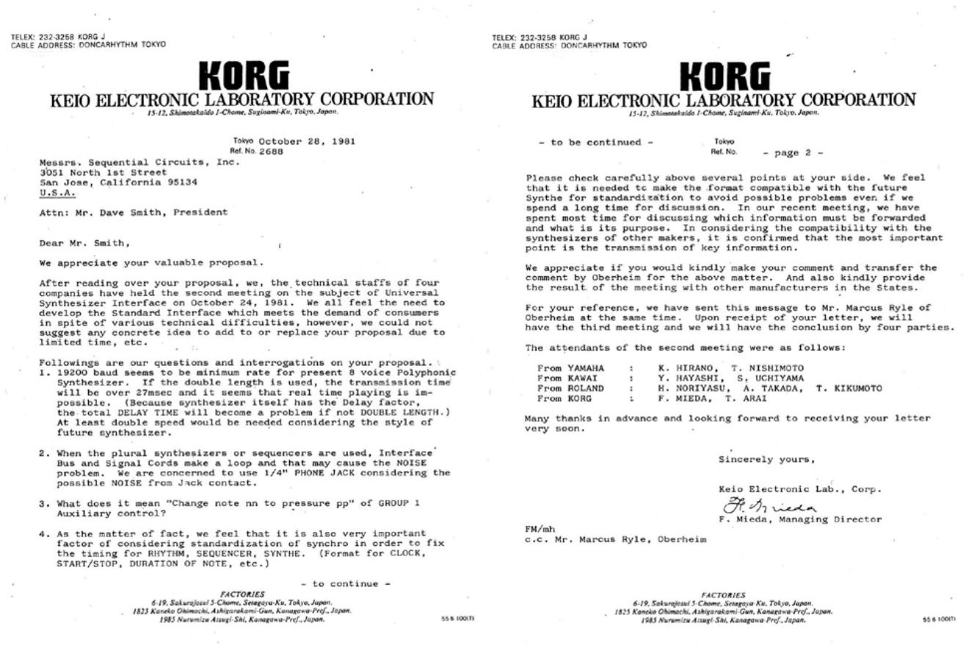
Audio Engineering Society
Los Angeles October 30, 1981
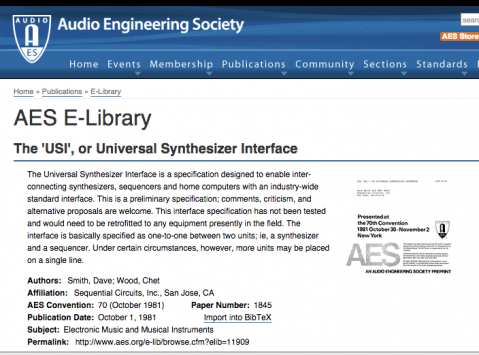
The Universal Synthesizer Interface is a specification designed to enable inter-connecting synthesizers, sequencers and home computers with an industry-wide standard interface. This is a preliminary specification; comments, criticism, and alternative proposals are welcome. This interface specification has not been tested and would need to be retrofitted to any equipment presently in the field. The interface is basically specified as one-to-one between two units; ie, a synthesizer and a sequencer. Under certain circumstances, however, more units may be placed on a single line.
Authors: Smith, Dave; Wood, Chet
Affiliation: Sequential Circuits, Inc., San Jose, CA
AES Convention: 70 (October 1981) Paper Number: 1845
Publication Date: October 1, 1981
Subject: Electronic Music and Musical Instruments
by Smith, Dave; Wood, Chet
Dave Smith and Chet Woods present a Universal Synthesizer Interface running at 19.2 k Baud, using regular 1/4″ phone jacks, but there are already on-going discussions about data speed, data format and different choices for connectors.
The 3rd Synthesizer Interface Conference
Tokyo, Japan December 24, 1981
The Japanese companies propose some significant changes to USI.
- Using a 5 PIN DIN cable or XLR cables (a locking cable was better for on stage use)
- Adding a UART with grounding to prevent noise (design by Karl Hirano from Yamaha)
The Yamaha proposal shown in Fig. 3.6 was submitted by 2025 MIDI Lifetime Achievement Award recipient Katsuhiko Hirano, who was then Chief of LM Design at Nippon Gakki Co., Ltd. and 2025 MIDI Lifetime Achievement Award recipient Tetsuo Nishimoto from the same department was in charge of drafting the plan.
The idea is to use an isolator to isolate the ground. A photocoupler is used for the circuit.
The Japanese companies also introduced the concept of the Status Byte to greatly expand the MIDI 1.0 protocol’s capapabilities.
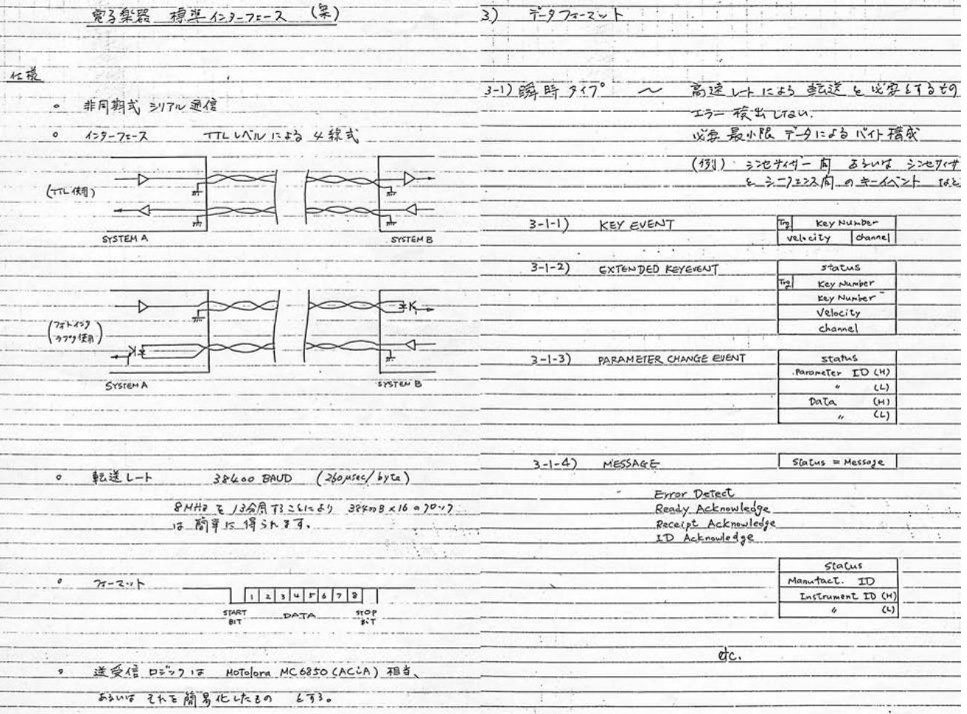
Roland proposed a slight modification of the hardware design and using a 5 PIN DIN which Roland was already using for DIn Sync although at the time, 5 PIN DIN connectors were still rare in the US.
2025 MIDI Lifetime Achievement Award recipient Tadao Kikumoto, General Manager of the Roland Osaka Technical Center made suggestions for Tempo, Start, Stop, Forward and Backward messages and also introduced the concepts of Running Status, and Status Bytes and Data Bytes.
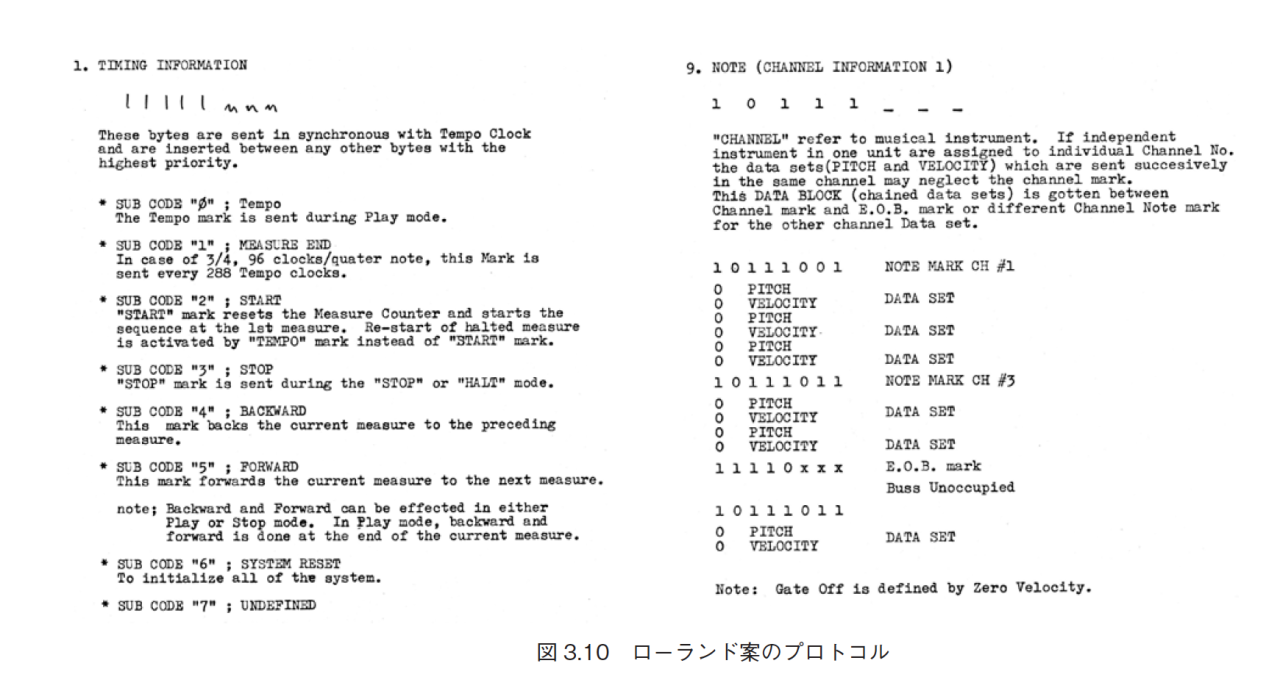
All of these were significant additions to the evolving MIDI Specification.
Whereas the USI was basically content to specify note on/off codes, this new proposal went on to define many more complex operations.
It also offered a different data structure, with status and data bytes being flagged by bit 7 O=status, O=data).
This greatly simplified the protocol by eliminating all the checks which were otherwise needed to distinguish the data category. With the most significant bit now defined as a “flag,” data is thereby limited to 7 bits, but this is sufficient for most synth data, and when not, can simply be sent as multiple 4–bit nibbles.

Stanley JungLeib
Preliminary Prophet 600 ManualMIDI Gets Its Name-Musical Instrument Digital Interface
At around the same time, there were discussions about the name of the new standard. There was concern that Universal Synthesizer Interface might cause some antitrust problems.
The Japanese suggested UMI Universal Music Interface (You-Me) and Dave Smith countered with the name we all know today- MIDI or Musical Instrument Digital Interface.
Winter NAMM
Anaheim, California Feb 5-7 1982
At the NAMM show in January 1982, a meeting with a number of synth manufacturers (Sequential, Roland, Oberheim, CBS/Rhodes, Yamaha, E-mu, Korg, Music Technology Inc., Kawai, Octave Plateau, Passport Designs, Syntauri and some others. but the companies could not agree on anything. The meeting did not go well. It was the American and European manufacturers who couldn’t agree. Some wanted expensive high data rate connectivity, others didn’t even see the point of an interface and so no consensus was reached and the meeting ended.
But after the meeting, Kakehashi-san from Roland sent Sakai-san to talk to Dave Smith encouraging him not to give up.
Dave explained it all in this 1997 video.
Stanley Jungleib also covered it in the MIDI history section of Prophet 600 manual (that was never shipped to the public).
There was a strong response to this initiative; some saying, for example, that it would not be possible to do it serially, that a parallel interface was necessary. Others thought the proposed serial speed too fast for operation with home computers. Many other issues were raised.
All respondents were invited to a conference in coincidence with the January, 1982 Western National Association of Music Merchants (NAMM) convention in Anaheim.
This meeting was attended by representatives from SCI, Roland, Oberheim, CBS/Rhodes, Yamaha, E-mu, Unicord (Korg), Music Technology Inc., Kawai, Octave Plateau, Passport Designs and Syntauri.
Other manufacturers seemed to be maintaining a “wait-and-see” policy.

Stanley JungLeib
Prophet 600 Preliminary ManualFax Communications between Sequential and Japanese companies
July 23, 1982
Sequential was planning on polyphonic synths with more polyphony. The original USI spec had 8 channels and at the time a channel equaled a monophonic voice. So originally the MIDI spec would have only allowed for 8 notes of polyphony.
Dave didn’t really want to tell the Japanese exactly what he was working on, but made some suggestions for improve the spec.
On July 23, 1982, a FAX was sent from Roland (serving as liaison for the Japanese companies) to Sequential Circuits agreed to:
- Increase the number of channels to 16 channels
- Distinguish between polyphonic and monophonic content

MIDI is finally ready for prime time.
Jeff Rona starts working for Roland on MIDI
Summer of 1982
Within a couple days I found myself in the office of Tom Beckman, the president of Roland US explaining my work and background. When he asked me if I wanted a job and could I write code for music software. I lied, basically, and said yes.
I became a programmer and instrument designer for Roland that day.
https://midi.org/midi-from-the-inside
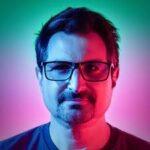
Jeff Rona,
MIDI from the InsideBrian Vincik connects with Sequential
Summer of 1982
2025 MIDI Association Lifetime Achievement Award recipient Brian Vincik, an engineer from Hewlett Packard starts discussions with John Bowen and Sequential about MIDI and starts to form ideas about the International MIDI Association, an organization to promote the idea of MIDI to companies and the public.
Bob Moog publicly announced MIDI in Keyboard Magazine
November, 1982
In a November 1982 article in Keyboard magazine, Robert Moog announced publicly that Smith and Wood had been working on an invention: MIDI.
The Prophet 600 Preliminary Manual
December, 1982
Brian Vincik provided with the MIDI Association with many files and one of the most interesting is the Prophet 600 Preliminary Manual written in December of 1982. It included a detailed MIDI History by Stanley Jungleib that was deleted from the actual manual that was shipped with the product.
Here is the MIDI History section of the Prophet 600 Preliminary Manual.
MIDI HISTORY
Stanley Jungleib, Sequential Circuits
Introduction
The Musical Instrument Digital Interface (MIDI) is a specification which enables manufacturers to design equipment that is basically compatible. This is most beneficial for the owner, whose equipment is thereby protected from obsolesence. As MIDI-compatible equipment is introduced, one will be able to freely choose keyboards, sequencers, and rhythm units from a variety of manufacturers with confidence that they will work together as one programmable system through which complete pieces can be composed and realized.
The problem of instrument compatibility is not new. It can be probably said of any two keyboards, that someone has desired if not actually tried to interconnect them. Keyboard couplers were developed for both pipe organs and harpsichords. In the heyday of electric organ technology this interest occasionally led to the installation of thick cables for wiring keyboards in parallel. The first synthesizers were easier to interface, because of the nature of modular equipment. However modules from different manufacturers might have incompatible control voltage, trigger, gate, and output levels or polarities. These differences have been promulgated in scores of synthesizer, keyboard, and effect devices, ultimately giving rise to an entire industry devoted to modifications and interfacing. And though they provide the best opportunity for interface so far, even microcomputer-based synthesizer equipment has been developed along independent, incompatible lines.
Like many other defacto “standards,” the MIDI has arisen primarily from the activities of those concerned that the incompatibility of current equipment discourages wider availability of the kinds of complex systems which can be envisioned utilizing even current technology. (The S-100 microcomputer buss evolved for similar reasons.) It is more than anything else the advent of the home computer which has forced music manufacturers to finally address the issue of compatibility. For the musician, the keyboard interface to the computer terminal offers the possibility of multi-track sequencing and editing, score display and printing. In this light the usefulness and need for a standard computer keyboard interface is obvious. Only with some such standard can these musical tools be developed.
The following explains how the MIDI specification resulted from this industry-wide consensus. The MIDI specification neither possesses nor claims any authority over equipment design. Rather, it is merely an informal agreement on some simple interface circuitry and the “grammar” of a non-proprietary language which can carry meaningful information between instruments. The incorporation or support of the MIDI facility in a product remains entirely a decision for each manufacturer.
GENERAL
The SCI Digital Interface
SCI first became interested in microcomputer interfacing in conjunction with the design of the Prophet-10 polyphonic synthesizer and its internal polyphonic sequencer. The Prophet and its sequencer each were based on Z-80 microcomputers. To record, as notes were played, every few milliseconds (at a rate set by the sequencer clock), the Prophet would send its complete keyboard “status” to the sequencer. The sequencer had to figure out which notes were going on and off, and record these events in reference to the clock count. On playback, the sequencer computer also sent the complete keyboard status every clock pulse, with events as counted out by the clock. The Prophet would play these notes just as if they came from its own keyboard. later, this sequencer was made available as an accessory for the Prophet-5. The Prophet-5 Remote Keyboard was also developed which used this interface. SCI published the data protocol upon which this interface was based, in the hopes that the programming public would be encouraged to develop their own interfaces for the Prophet-5.
This did not occur, apparently because in being conceived for a specific application, the interface was very fast but too clumsy for general-purpose use. It was criticized as requiring too much programming “overhead,” in the constant transmission of meaningless keyboard information. As a result of this experience, SCI resolved to pursue a more streamlined interface that would be easier for programmers to work with.
The Universal Synthesizer Interface
In the meantime, occasional discussions between the presidents of Sequential Circuits (SCI), Oberheim Electronics, and Roland (Dave Smith, Tom Oberheim and Ikutaroo Kakehashi) also revealed a shared interest in the interface problem and development of an interface widely acceptable to the industry.
Smith then outlined a specification for a “Universal Synthesizer Interface” (USI). It was developed with the assistance of SCI’s Chet Wood and presented at the Fall, 1981 convention of the Audio Engineering Society (AES).
The USI differed markedly from the earlier SCI Digital interface in that rather than being polled at the sequencer clock rate, information was only sent when an event actually occured–for example, a note going on or off. The USI was proposed to be serial, operating at 19.2 kBaud, with TTL levels, and connected through phone jacks.
After incorporating changes in response to comments from AES, Smith sent a questionnaire to all manufacturers and industry consultants he could find, asking for their suggestions and any special requirements. There was a strong response to this initiative; some saying, for example, that it would not be possible to do it serially, that a parallel interface was necessary. Others thought the proposed serial speed too fast for operation with home computers. Many other issues were raised.
All respondents were invited to a conference in coincidence with the January, 1982 Western National Association of Music Merchants (NAMM) convention in Anaheim. This meeting was attended by representatives from SCI, Roland, Oberheim, CBS/Rhodes, Yamaha, E-mu, Unicord (Korg), Music Technology Inc., Kawai, Octave Plateau, Passport Designs and Syntauri.
Other manufacturers seemed to be maintaining a “wait-and-see” policy.
At this meeting the chief changes which occured to the USI were to add optoisolation to prevent audio ground loops, and to increase the speed to 31.25 kBaud.
The Japanese Interface Proposal
Following the USI discussion at Anaheim, an alternative specification was presented by some of the Japanese companies which had grown out of their own research. Whereas the USI was basically content to specify note on/off codes, this new proposal went on to define many more complex operations. It also offered a different data structure, with status and data bytes being flagged by bit 7 O=status, O=data). This greatly simplified the protocol by eliminating all the checks which were otherwise needed to distinguish the data category. With the most significant bit now defined as a “flag,” data is thereby limited to 7 bits, but this is sufficient for most synth data, and when not, can simply be sent as multiple 4–bit nibbles.
The MIDI
After the Anaheim meeting, Smith and Wood integrated the USI and Japanese proposals, forming the first MIDI specification. This was sent to all of the meeting participants but, curiously, provoked no further comment from this continent.
The final document was therefore arrived at after several exchanges between SCI and Roland, which is serving as liason with Yamaha, Korg, and Kawai.
The development of MIDI was first made public by Robert Moog, in his October, 1982 column in KEYBOARD magazine.
In December of 1983, SCI began shipping the Prophet-600, the first commercially available instrument to include the MIDI.
1983 Winter NAMM
Anaheim, California Jan 21-23 1983

The stage was finally set for the first public demonstration of MIDI. Here is the iconic picture of the first demonstration of MIDI between a Sequential Circuits 600 and a Roland Jupiter 6.
2025 MIDI Association Lifetime Achievement Award recipient John Bowen is the person with his back to the camera wearing the red Sequential Circuits jacket.
It’s very likely that many of the 2025 MIDI Association Lifetime Achievement recipients are in the audience including Karl Hirano, Tadao Kikumoto, Tetsuo Nishimoto, Chris Meyer, Jeff Rona and Brian Vincik.
Dave Smith said that they were not sure if the MIDI demo would work at all, but it did. He also said he was late to the Roland booth. Security guards didn’t want to let him in because he didn’t have a NAMM property pass.
MIDI is not yet a standard and there is no official specification to share and no standards organization in either Japan or the rest of the world.
But MIDI was about to shake up the world for the next 40 years.
In our next chapter, we will look at the first tumultuous years of MIDI between the winter of 1983 and the Summer NAMM in 1985 when the MIDI Manufacturers Association was established.
Article Source Acknowledgements
We wanted to acknowledge the key people who made this official history of the birth of MIDI possible.
These are people who were directly involved with the creation of MIDI in its early days. Some of these people have never been appropriately acknowledged for their contributions and that is one of the reasons for creating this detailed history of how MIDI came about.
Also it became clear in the intense research that went into this article, that MIDI was always about connections and not just connections between products, but more importantly connections between people.
There is the well known phrase “it takes village” and MIDI is a great example of how that is true. MIDI was not developed by two people or two companies, it was a group of individuals with different backgrounds and motivations who came together to do something for the greater good.
That said, we would be remiss if we did not acknowledge several key people who contributed first person resources and interviews to this article.
John Bowen- 2025 MIDI Association Lifetime Achievement Award Recipient
Head of Sound Design for Sequential Circuits, Korg R and D and now President of John Bowen Synth Design, maker of the Solaris synthesizer.
John provided insight into the interconnections between Moog and Sequential as well as multiple interviews on the early days of MIDI.
Hideki Izuchi– Roland Engineer
Izuchi-san created a report about the birth of MIDI that was presented in 2018 at the Japan National Museum of Science in Ueno Park, Tokyo. His incredibly detailed 72 page report entitled “Technical Systematic Survey on MIDI” provided much of the information for this article and confirmed many details from the Japanese side about the development of MIDI.
Jeff Rona- 2025 MIDI Association Lifetime Achievement Award Recipient
Composer and Founder and first President of the MIDI Manufacturers Association (MMA, now known simply as the MIDI Association)
Jeff provided the MIDI Association access to the very earliest communications of the MIDI Association in its infancy. As the very first President of the MIDI Manufacturers Association guided MIDI through its formulative and frankly most turbulent early years.
Chris Meyer- 2025 MIDI Association Lifetime Achievement Award Recipient
Chris worked at both Sequential Circuits and Roland and was the first chair of the MMA Technical Standards Board).
In researching this article, we realized that the simple story that Roland and Sequential connected a Prophet 600 and a Jupiter 6 together at the 1983 NAMM show and that instantly MIDI became an overnight success was very far from the reality of what was happened between January 1983 and May of 1985 when the MIDI Manufacturers Association was formally created as a non-profit trade association.
Brian Vincek– 2025 MIDI Association Lifetime Achievement Award Recipient
Vice President at Hewlett-Packard and co-founder of the International MIDI Association
Brian provided access to all of the early files of the International MIDI Association (IMA). Brian and John worked closely in the very early days of MIDI and the IMA was responsible for the distribution of the initial MIDI specification to both MMA companies and individuals. His contributions to the very early days of MIDI were substantial and the files he provided for this article were invaluable.
Stanley Junglieb- Sequential Circuits and Seer Systems
Stanley wrote the Prophet 600 Preliminary Manual which contained a comprehensive early history of MIDI and allowed us to confirm many of the details we received from the Japanese sources. Stanley continued to work at Sequential and then rejoined Dave Smith to work at Seer Systems implementing some of the very first software synths back in 1994.